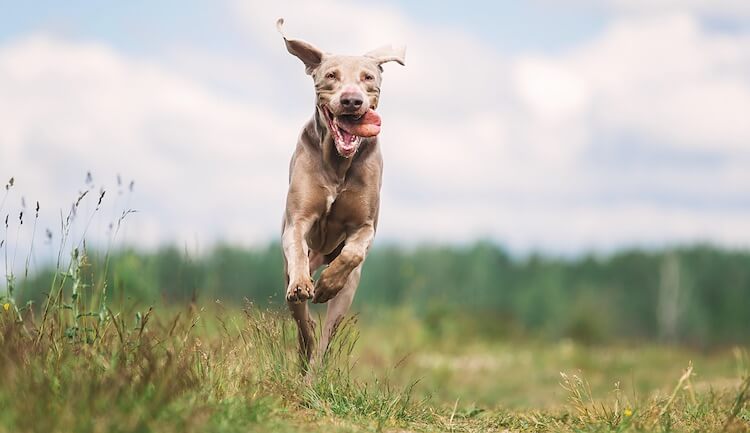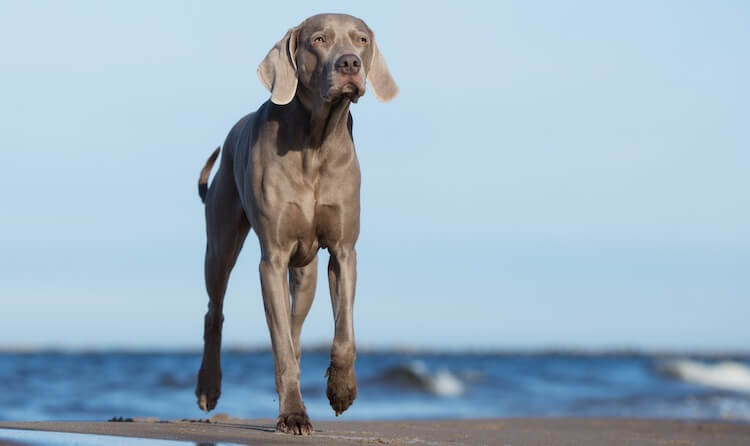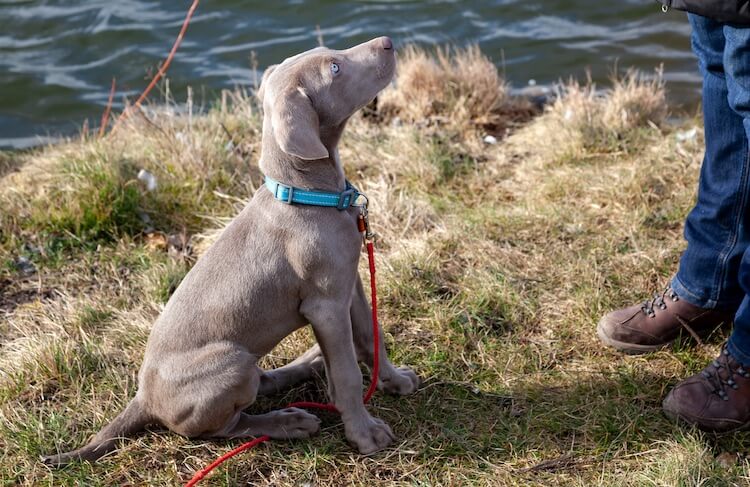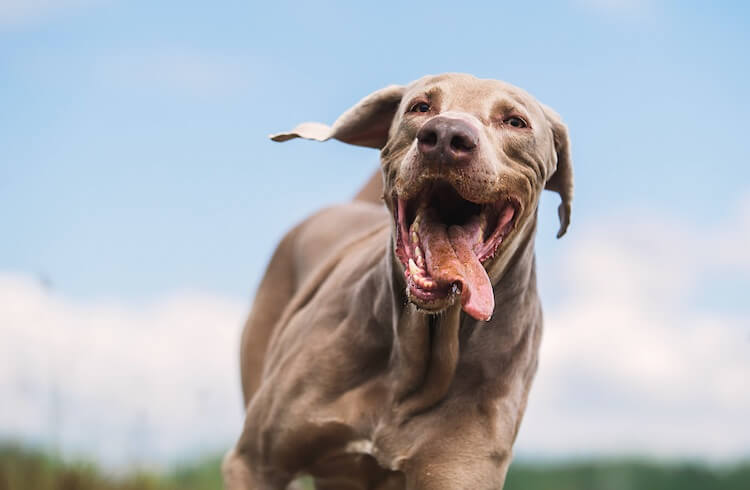
Every dog owner knows a Weimaraner when they see one. Easily identifiable by their long legs, silver coat, and goofy expressions, these dogs have a long and regal history.
Sometimes known as Weims, this breed originated in Germany as a hunting dog.
They are now becoming more popular as companion dogs, slowly moving away from their hunting roots. But, is this dog well suited to family life? And how well do they compare to similar silver dogs?
If you are thinking about bringing home a Weimaraner, here are 12 must know facts before you decide to adopt.
TABLE OF CONTENTS
- 12. Long-Haired Weimaraners Are Not Recognized
- 11. They Don't Like Apartments
- 10. Weimaraners Are Friendly, Fearless & Alert
- 9. This Breed Is Very Athletic
- 8. They Are Predisposed To A Few Health Conditions
- 7. Weimaraners Love To Learn
- 6. The Weimaraner Is German
- 5. This Breed Is A Descendent Of Bloodhounds
- 4. They Are Great At Canine Sports
- 3. Weimaraners Are An Excellent Choice For Families
- 2. They Require A High Protein Diet
- 1. They Need Regular Grooming
12. Long-Haired Weimaraners Are Not Recognized
The Weimaraner has a very distinctive short, silver grey coat. They must be distinctively short haired and grey, otherwise they are not accepted by the American Kennel Club for registration.
They are the only kennel club in the world that does not recognize long-haired variations.
While alternate colors and coat length are available, they are not recognized and therefore may be harder to come by.
The long-haired coat is recessive, so will only present if both the parents are carriers. The coat is long and soft, and when left undocked there is usually feathering on the tail (like a Golden Retriever).
11. They Don’t Like Apartments
Known to enjoy spending time outdoors in large open spaces, Weimaraners do not do well in cities or tiny apartments; these long-legged dogs need room to stretch out
This breed is known to love to bark when bored and/or confined.
Giving them lots of time outdoors and space within the house will help to reduce this behavior.
10. Weimaraners Are Friendly, Fearless & Alert

Described by their breed standard, this breed should be:
- Friendly
- Fearless
- Alert
- Obedient
Weimaraners are not known to be nervous or anxious dogs, instead are outgoing and sociable.
This breed to naturally love their owners. This is because of their working heritage where they would bond during hunts. They are absolutely dedicated to their person or people, and as a result can suffer from severe separation related issues.
Owning or adopting this breed requires lots of training to prepare your dog for being left on their own. If left unprepared, they will howl, bark, whine and even destroy furniture in attempt to get back to their owner.
To combat this, owners should do lots of exercises to foster independence in their dog, such as teaching how to self-entertain and using things like puzzle toys to facilitate this.
9. This Breed Is Very Athletic

Long legs, an athletic body and a striking silver coat makes them easy to pick out at the dog park! Not to mention their goofy expressions and personality (but more on this later).
These dogs are known to be long and lanky, standing at between 22 and 28 inches tall. Their compact body makes them look like they are all legs. They are very light for their size, weighing between 55 and 88 pounds. Females are usually shorter and lighter than males (although this is not exclusively true).
Weimaraners have a very distinct appearance, they are not difficult to spot.
One important thing is their tail. Traditionally, their tails would be docked within the first few days of their life.
However, opinions on tail docking have changed during this dog’s 200 year history. Docking now varies depending on kennel club and country. The American Kennel Club’s breed standard calls for tail docking, where the tail is docked to be six inches long.
8. They Are Predisposed To A Few Health Conditions

Unfortunately, Weims as a breed are predisposed to a few health conditions. Although most of them live long, healthy lives, often living between 11 and 14 years, there are a few potential conditions they can develop that owners should be aware of.
As with other large breeds, they have the potential to develop hip dysplasia.
Hip dysplasia is an incorrect formation of the hip joint, whereby the cartilage in the joint is incorrectly formed or damaged. Overtime the cartilage in the joint will degrade, causing pain upon movement.
There is no cure for hip dysplasia. Depending on the severity of the condition, it can be managed either via anti-inflammatory pain medication or in more extreme cases, surgery.
Gastric dilatation-volvulus, better known as bloat (or gastric torsion), is a condition whereby the stomach fills with gas and then twists, so that the gas cannot escape. This is an incredibly painful condition for your dog and requires immediate medical care. This breed is at risk because they are a large og.
There are also some reports of Weimaraners developing hyperthyroidism.
Hyperthyroidism is where the dog produces too much of the thyroid hormone. Most owners will notice that their dogs are drinking more and will generally be losing weight.
If you see any of these symptoms in your dog, contact your veterinarian as soon as possible.
7. Weimaraners Love To Learn

Because of their love to learn, they are very easy to train! With patience and positive reinforcement dog training techniques, they will be quite literally jumping through hoops to please you.
One common misconception is that to train a hunting dog you have to show them who’s boss. Simply put, this is just not true. Weimaraners, like any dog, learn through consequences:
- If you reward your dog for good behavior, it is more likely to repeat that.
- If you punish your dog for being naughty, this will not prevent the behavior, rather damages your relationship with your dog and will ultimately lead to confusion.
With some patience, and a lot of practice, a Weimaraner can pull off tricks that will dazzle all your friends.
Due to their skill at retrieving, you may want to train your dog to do other fun novelty type tricks, like getting you a drink from the fridge or the remote for the TV.
6. The Weimaraner Is German

First seen in the 19th century, the Weimaraner is a German dog breed. Bred to hunt, they would often be owned by royalty who were in charge of hunting game such as boar and deer.
They get their name from a Duke (who lived in the city of Weimar). One of their early breeders, Duke Karl August, enjoyed hunting and consequently owned many. August is thought to have been key in the creation of the Weim, obsessed with creating the perfect hunting dogs.
This breed first began to arrive in America in the late 1920s.
Though not initially popular, their popularity began to climb in the 1950s. This may be linked to their official breed recognition by the American Kennel Club in 1943.
5. This Breed Is A Descendent Of Bloodhounds
It is widely believed that this breed descended from the Hubert Hound and the Chien-gris dog (both of which are descended from the bloodhound).
This explains why they have an excellent ability to locate game via scent. However, these are all theories, the exact history of this breed is actually unknown.
What is known is that, overtime, as there became less big game in Europe, Weimaraners adapted and became popular as a general purpose hunting dog. They would often be used to retrieve game like Labradors (hence the love of fetch we see in modern Weimaraners).
In the 21st century, this breed is more likely to be kept as a family pet than a gun dog. Though there are still some working bloodline lines in Europe.
4. They Are Great At Canine Sports

It should come as no surprise that a dog who is bred to chase animals enjoys exercise.
On average, a Weimaraner will need 90 minutes of exercise each day. This should be high energy, aerobic exercise, walking or hiking outdoors. This can include canine sports, such as agility or flyball.
Due to their gundog heritage, these dogs love to play chase, especially games like fetch. Try mixing up the game by using scent balls. Alternatively, playing games like hide and seek can be a fun activity to do with you dog.
Given that their job was to bring things back to their owners, Weimaraners generally have pretty good recall with a little bit of training.
As puppies, they do not need nearly as much exercise. You should take your dog on shorter walks to avoid joint and bone issues during growth.
3. Weimaraners Are An Excellent Choice For Families

This dog needs an active family who will give them the exercise they need to get by.
If you are just looking for a family pet that will snooze on the sofa all day, this is not the dog for you. Try looking for a French Bulldog.
Owners need to be able to keep up with their active dogs, taking them hiking, swimming and trail walking.
Like most dogs, they can do very well with other dogs if they are properly introduced to them as puppies. Correct socialization will help your puppy to settle around other dogs.
Sometimes, their natural instinct to chase may impede their ability to get on with other cats. Some may be able to get past this and even become friends with a cat, but most will want to follow their natural predatory instinct and chase.
They do best in homes with active older children; their boisterous and playful nature can cause accidents with very young children. Although they mean well, their long legs and love of games can knock an unsteady child off their feet.
2. They Require A High Protein Diet

Being a lean, muscular dog they require a carefully balanced diet to live to their full potential.
On average, he will need three cups of high-quality food each day (dogs that are neutered may require slightly less). Where possible, this should be split into two smaller meals to balance out caloric intake throughout the day.
Because of their active nature, this breed needs a very high protein diet. Owners should aim to feed 38% protein and 15% fat, to help maintain muscle mass.
Weimaraners are known for having very sensitive stomachs. Dietary allergies often present as a lack of appetite and skin issues, and so this is something to be aware before adopting.
To maintain their sleek body, you should be careful not to overfeed them.
1. They Need Regular Grooming
The Weimarner dog has a short, stiff single coat that will shed moderately throughout the year. This coat does not need clipping at all but will need a frequent going over with a rubber brush to remove loose hair and skin.
Owners should aim to do this about twice a week. Treating this as a fun and positive experience for your pup will help to promote it as such. You may find some resistance to grooming if the dog is forced to participate.
Consequently, you should use option-based training, such as the bucket game. This will help to promote active participation in grooming. This allows the dog to view grooming as a positive experience and choose when they have grooming done.
As with other dogs, nails should be clipped every six to eight weeks and their teeth should be brushed every week or so.
Is The Weimaraner Right For You?
The Weimaraner is an excellent match for an active family, couple or single who are looking for a dog to get back to nature with.
These dogs love to be outside, hiking through the foothills of a mountain or swimming in a lake. They are also very intelligent, meaning they require lots of mental stimulation as well as physical.
Compared to their intense activity requirements, they have very low grooming requirements. They do not need through regular grooming, just the occasional brush down to remove dead hair and skin.
Are you thinking about getting a Weimaraner? Leave us a comment to let us know.




Be the first to comment